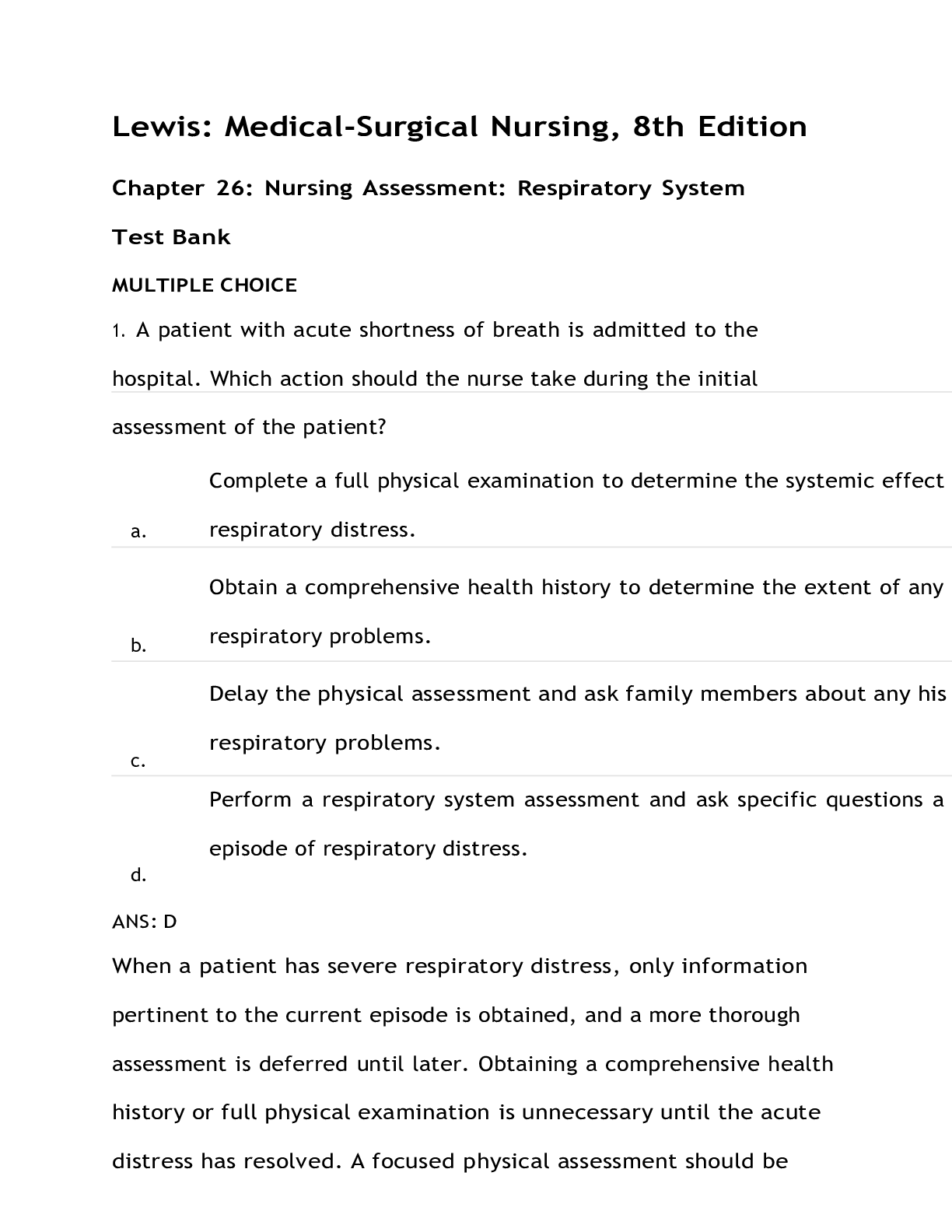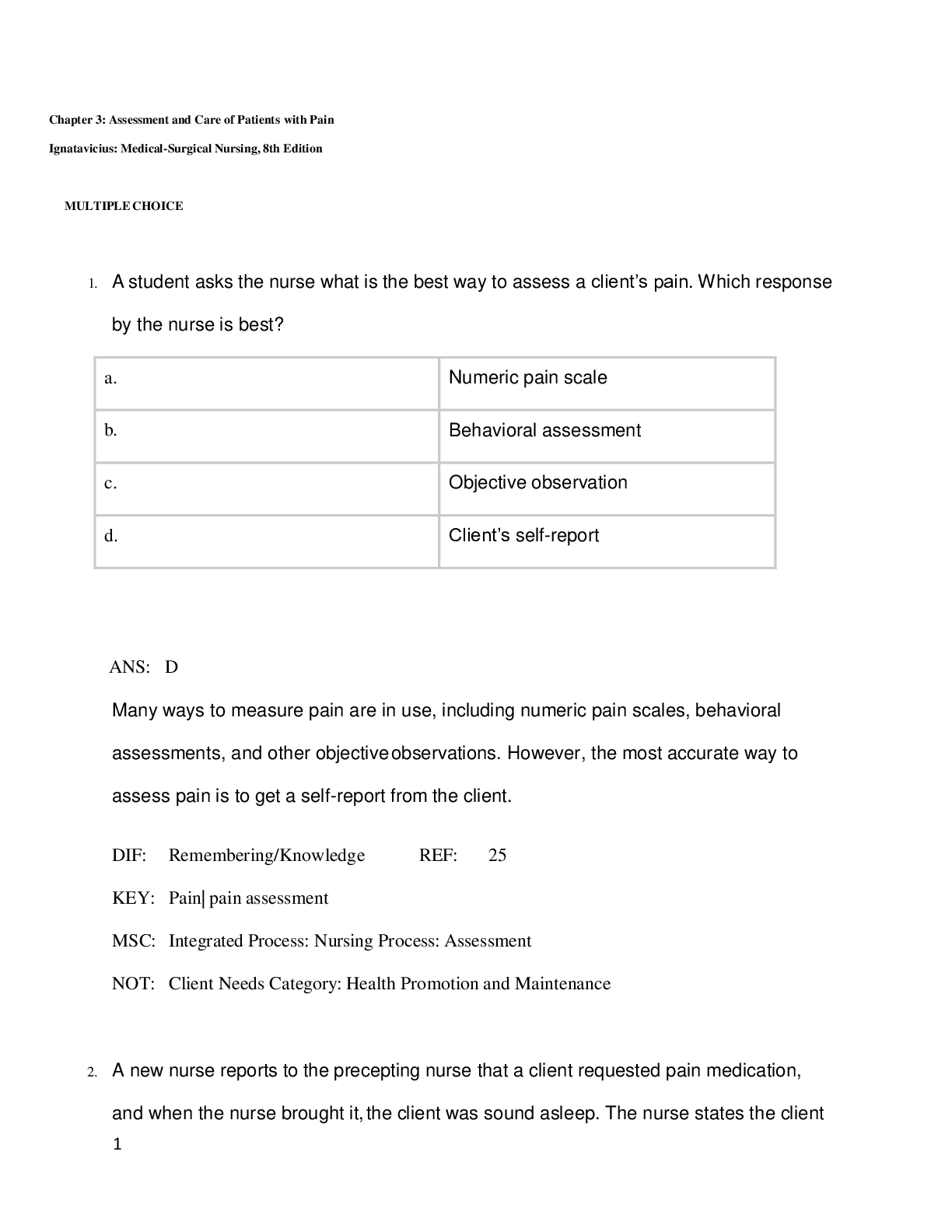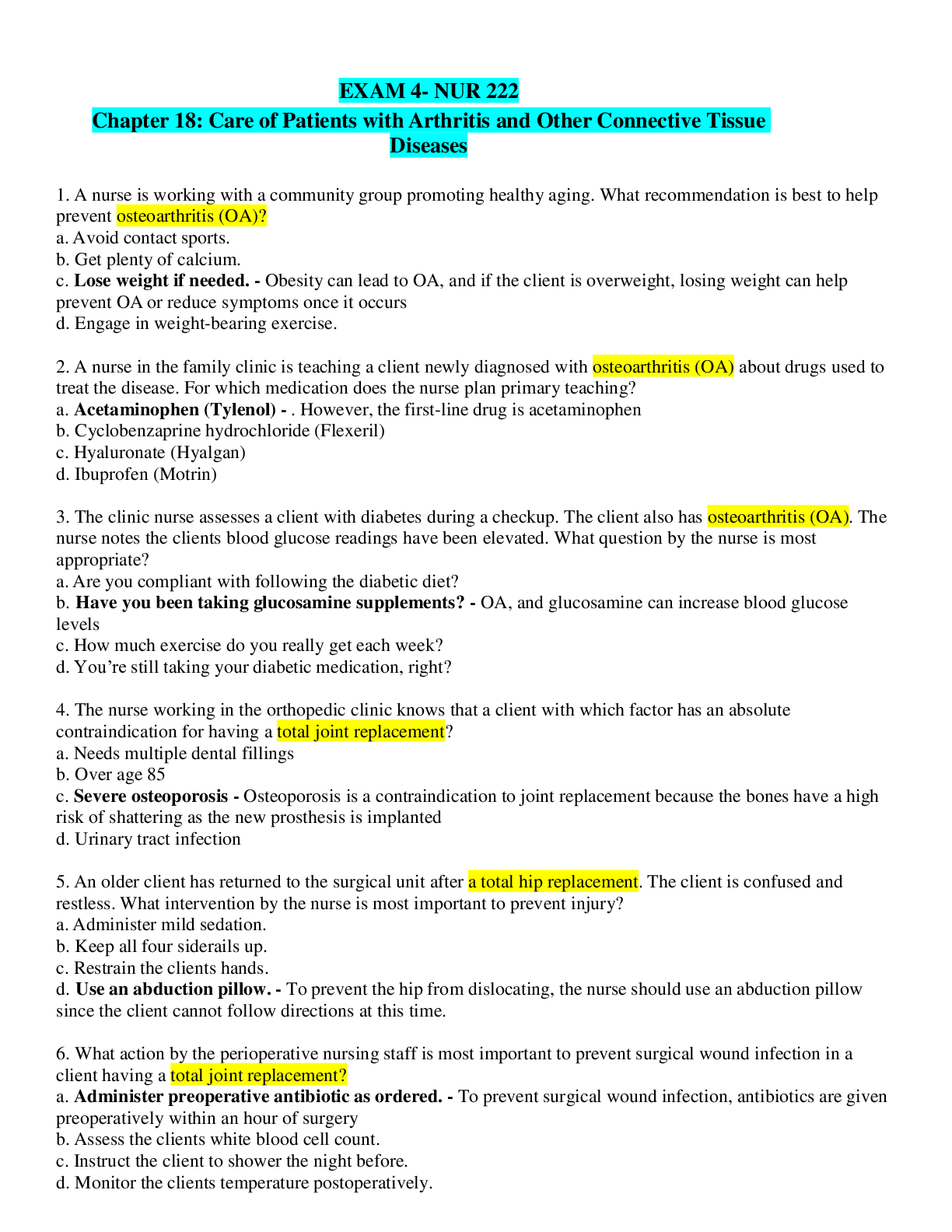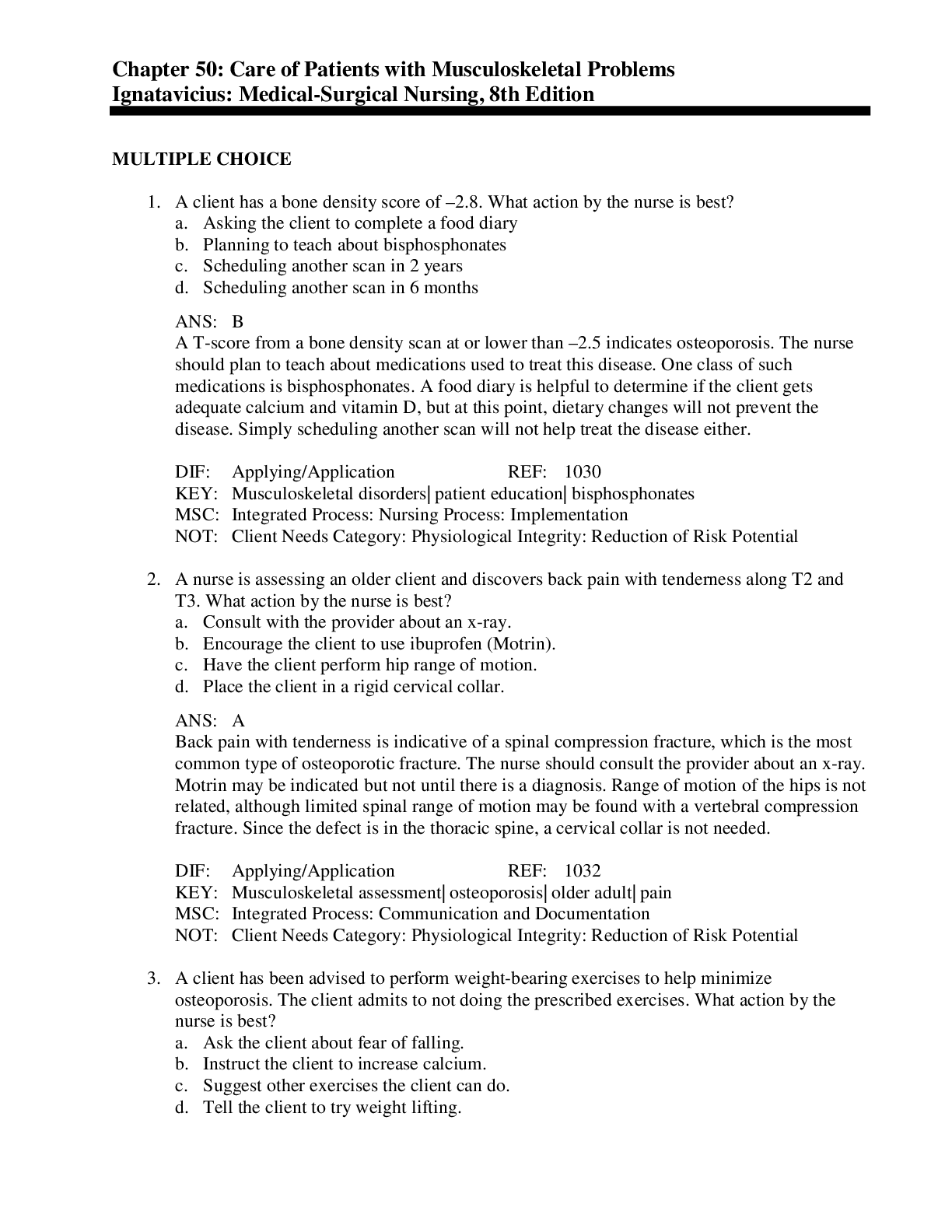*NURSING > QUESTIONS & ANSWERS > Care of Patients with Arthritis and Other Connective Tissue Diseases Ignatavicius: Medical-Surgical (All)
Care of Patients with Arthritis and Other Connective Tissue Diseases Ignatavicius: Medical-Surgical Nursing, 8th Edition
Document Content and Description Below
Chapter 18: Care of Patients with Arthritis and Other Connective Tissue Diseases Ignatavicius: Medical-Surgical Nursing, 8th Edition MULTIPLE CHOICE 1. A nurse is working with a community group ... promoting healthy aging. What recommendation is best to help prevent osteoarthritis (OA)? a. Avoid contact sports. b. Get plenty of calcium. c. Lose weight if needed. d. Engage in weight-bearing exercise. 2. A nurse in the family clinic is teaching a client newly diagnosed with osteoarthritis (OA) about drugs used to treat the disease. For which medication does the nurse plan primary teaching? a. Acetaminophen (Tylenol) b. Cyclobenzaprine hydrochloride (Flexeril) c. Hyaluronate (Hyalgan) d. Ibuprofen (Motrin) 3. The clinic nurse assesses a client with diabetes during a checkup. The client also has osteoarthritis (OA). The nurse notes the client’s blood glucose readings have been elevated. What question by the nurse is most appropriate? a. “Are you compliant with following the diabetic diet?” b. “Have you been taking glucosamine supplements?” c. “How much exercise do you really get each week?” d. “You’re still taking your diabetic medication, right?” 4. The nurse working in the orthopedic clinic knows that a client with which factor has an absolute contraindication for having a total joint replacement? a. Needs multiple dental fillings b. Over age 85 c. Severe osteoporosis d. Urinary tract infection 5. An older client has returned to the surgical unit after a total hip replacement. The client is confused and restless. What intervention by the nurse is most important to prevent injury? a. Administer mild sedation. b. Keep all four siderails up. c. Restrain the client’s hands. d. Use an abduction pillow. 6. What action by the perioperative nursing staff is most important to prevent surgical wound infection in a client having a total joint replacement? a. Administer preoperative antibiotic as ordered. b. Assess the client’s white blood cell count. c. Instruct the client to shower the night before. d. Monitor the client’s temperature postoperatively. 7. The nurse on the postoperative inpatient unit assesses a client after a total hip replacement. The client’s surgical leg is visibly shorter than the other one and the client reports extreme pain. While a co-worker calls the surgeon, what action by the nurse is best? a. Assess neurovascular status in both legs. b. Elevate the affected leg and apply ice. c. Prepare to administer pain medication. d. Try to place the affected leg in abduction. 8. A client has a continuous passive motion (CPM) device after a total knee replacement. What action does the nurse delegate to the unlicensed assistive personnel (UAP) after the affected leg is placed in the machine while the client is in bed? a. Assess the distal circulation in 30 minutes. b. Change the settings based on range of motion. c. Raise the lower siderail on the affected side. d. Remind the client to do quad-setting exercises. 9. After a total knee replacement, a client is on the postoperative nursing unit with a continuous femoral nerve blockade. On assessment, the nurse notes the client’s pulses are 2+/4+ bilaterally; the skin is pale pink, warm, and dry; and the client is unable to dorsiflex or plantarflex the affected foot. What action does the nurse perform next? a. Document the findings and monitor as prescribed. b. Increase the frequency of monitoring the client. c. Notify the surgeon or anesthesia provider immediately. d. Palpate the client’s bladder or perform a bladder scan. 10. A nurse is discharging a client to a short-term rehabilitation center after a joint replacement. Which action by the nurse is most important? a. Administering pain medication before transport b. Answering any last-minute questions by the client c. Ensuring the family has directions to the facility d. Providing a verbal hand-off report to the facility 11. A nurse works in the rheumatology clinic and sees clients with rheumatoid arthritis (RA). Which client should the nurse see first? a. Client who reports jaw pain when eating b. Client with a red, hot, swollen right wrist c. Client who has a puffy-looking area behind the knee d. Client with a worse joint deformity since the last visit 12. A client with rheumatoid arthritis (RA) is on the postoperative nursing unit after having elective surgery. The client reports that one arm feels like “pins and needles” and that the neck is very painful since returning from surgery. What action by the nurse is best? a. Assist the client to change positions. b. Document the findings in the client’s chart. c. Encourage range of motion of the neck. d. Notify the provider immediately. 13. The nurse working in the rheumatology clinic is seeing clients with rheumatoid arthritis (RA). What assessment would be most important for the client whose chart contains the diagnosis of Sjögren’s syndrome? a. Abdominal assessment b. Oxygen saturation c. Renal function studies d. Visual acuity 14. The nurse is working with a client who has rheumatoid arthritis (RA). The nurse has identified the priority problem of poor body image for the client. What finding by the nurse indicates goals for this client problem are being met? a. Attends meetings of a book club b. Has a positive outlook on life c. Takes medication as directed d. Uses assistive devices to protect joints 15. A client is started on etanercept (Enbrel). What teaching by the nurse is most appropriate? a. Giving subcutaneous injections b. Having a chest x-ray once a year c. Taking the medication with food d. Using heat on the injection site 16. The nurse in the rheumatology clinic is assessing clients with rheumatoid arthritis (RA). Which client should the nurse see first? a. Client taking celecoxib (Celebrex) and ranitidine (Zantac) b. Client taking etanercept (Enbrel) with a red injection site c. Client with a blood glucose of 190 mg/dL who is taking steroids d. Client with a fever and cough who is taking tofacitinib (Xeljanz) 17. A client with rheumatoid arthritis (RA) has an acutely swollen, red, and painful joint. What nonpharmacologic treatment does the nurse apply? a. Heating pad b. Ice packs c. Splints d. Wax dip .....................................................................CONTINUED..................................................................... [Show More]
Last updated: 1 year ago
Preview 1 out of 20 pages
 (1).png)
Buy this document to get the full access instantly
Instant Download Access after purchase
Add to cartInstant download
We Accept:

Reviews( 0 )
$12.00
Document information
Connected school, study & course
About the document
Uploaded On
Apr 11, 2021
Number of pages
20
Written in
Additional information
This document has been written for:
Uploaded
Apr 11, 2021
Downloads
0
Views
37



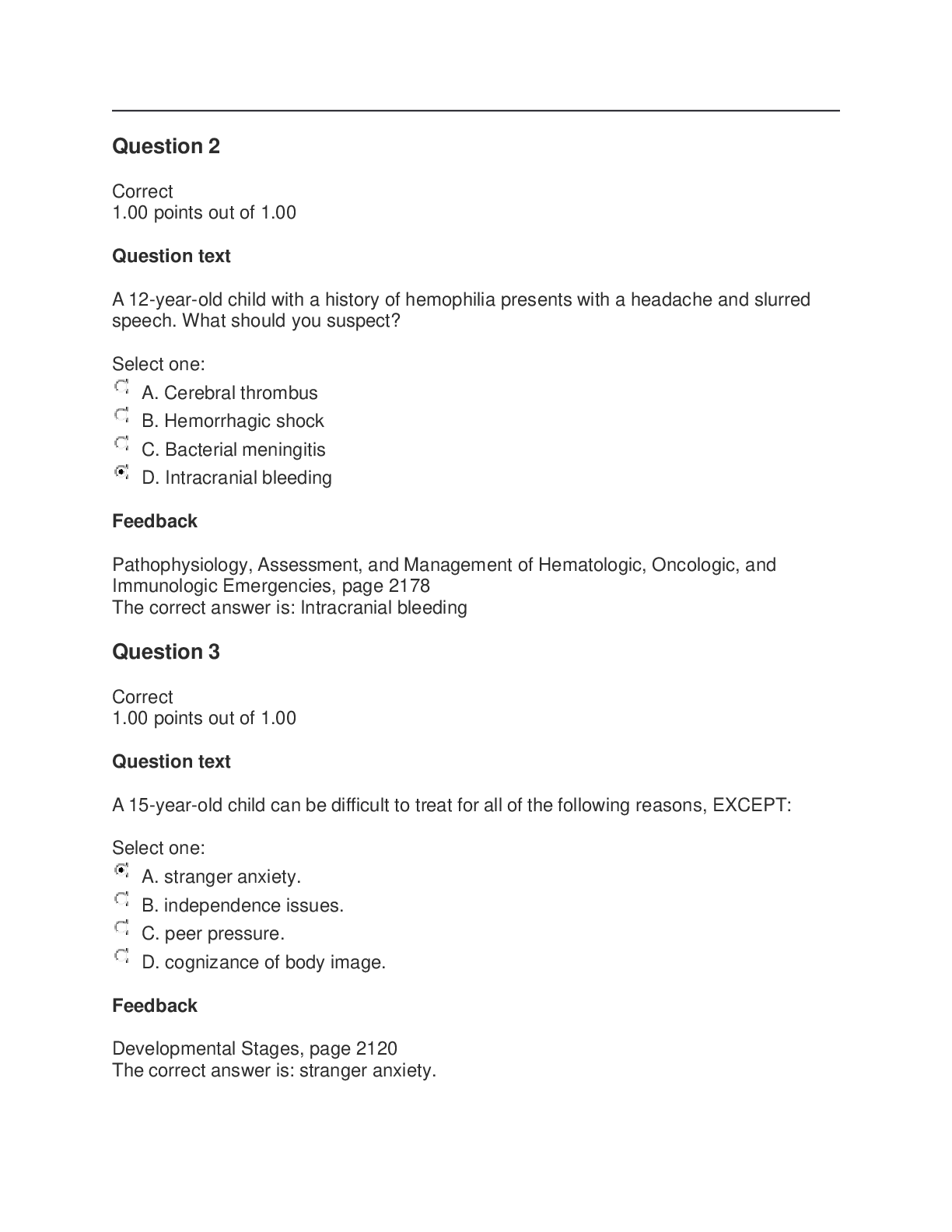
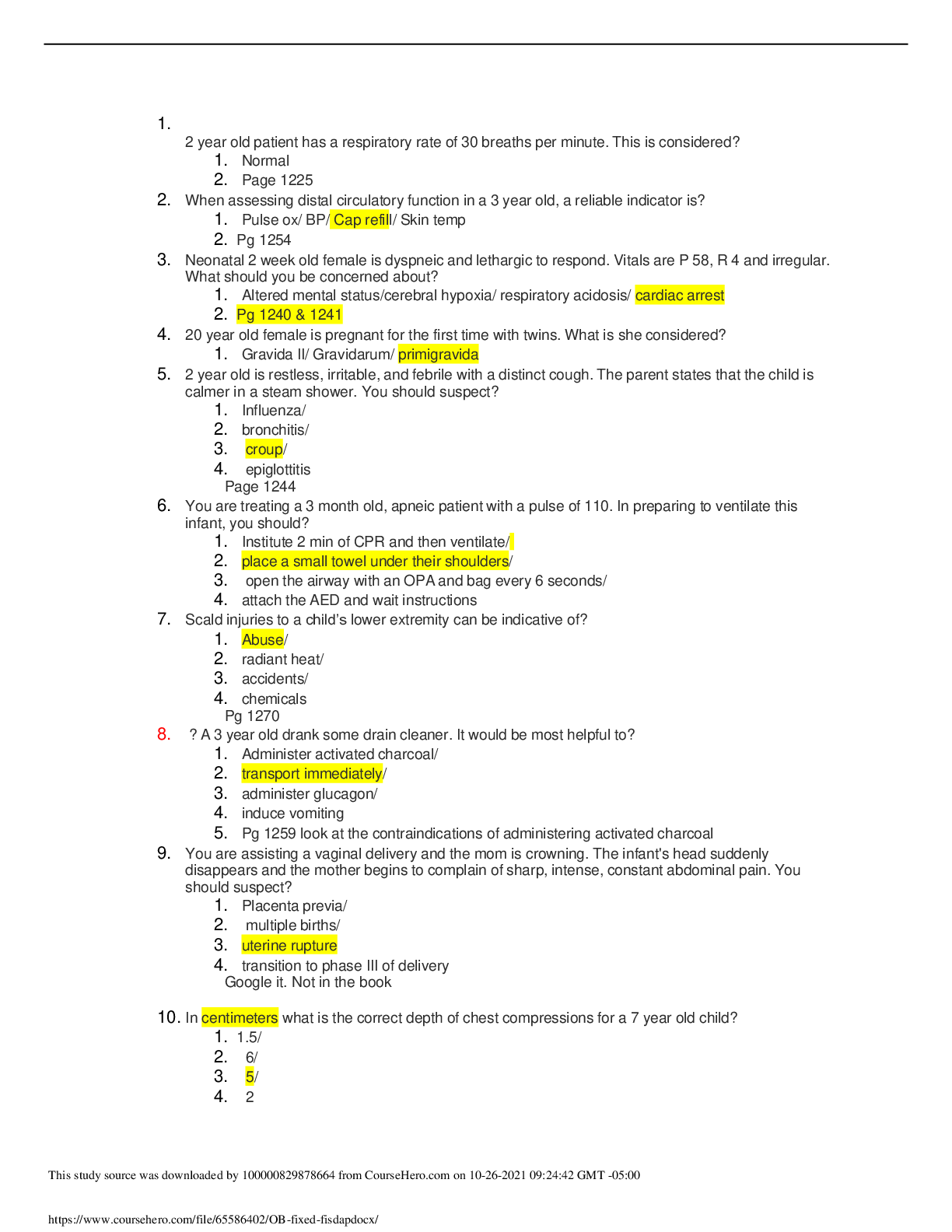
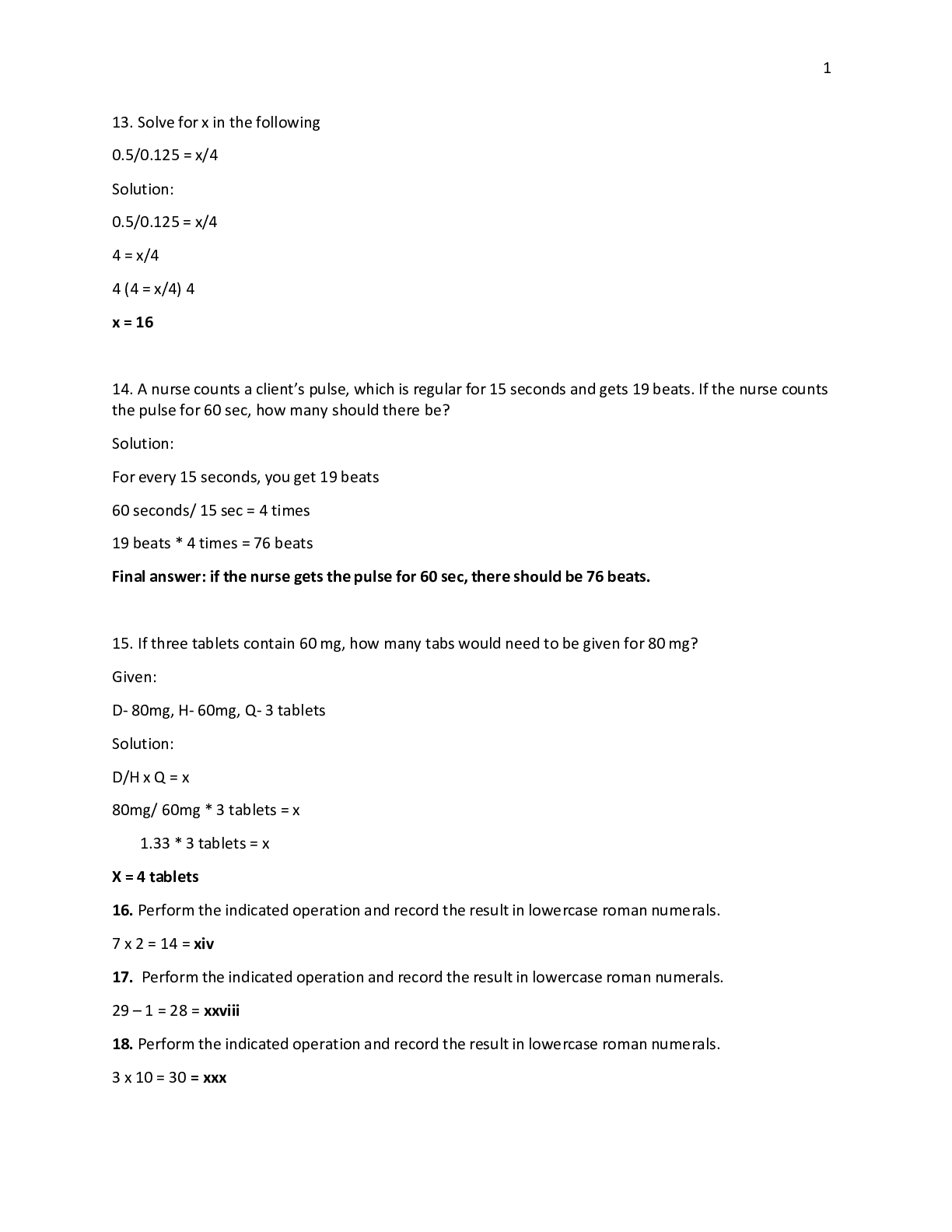


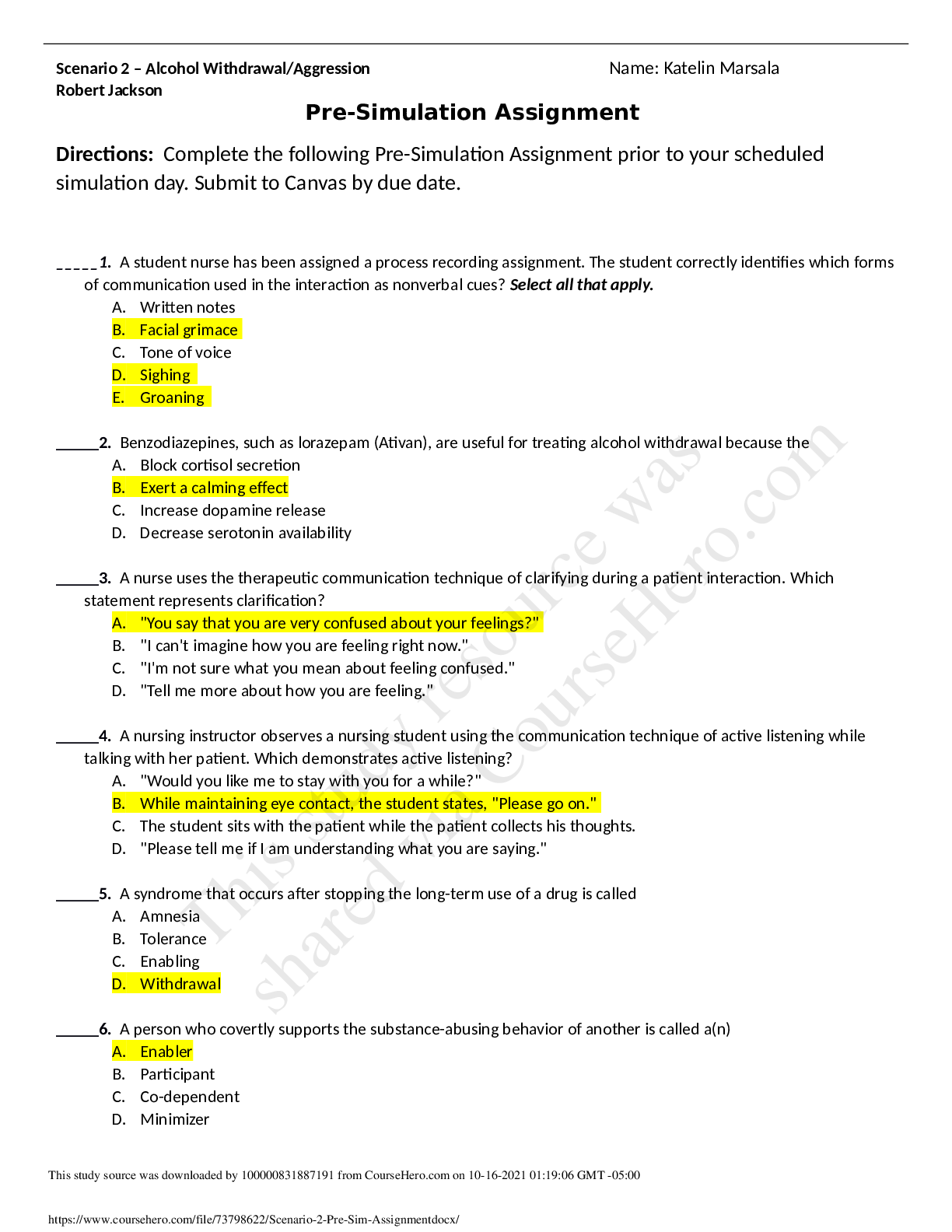

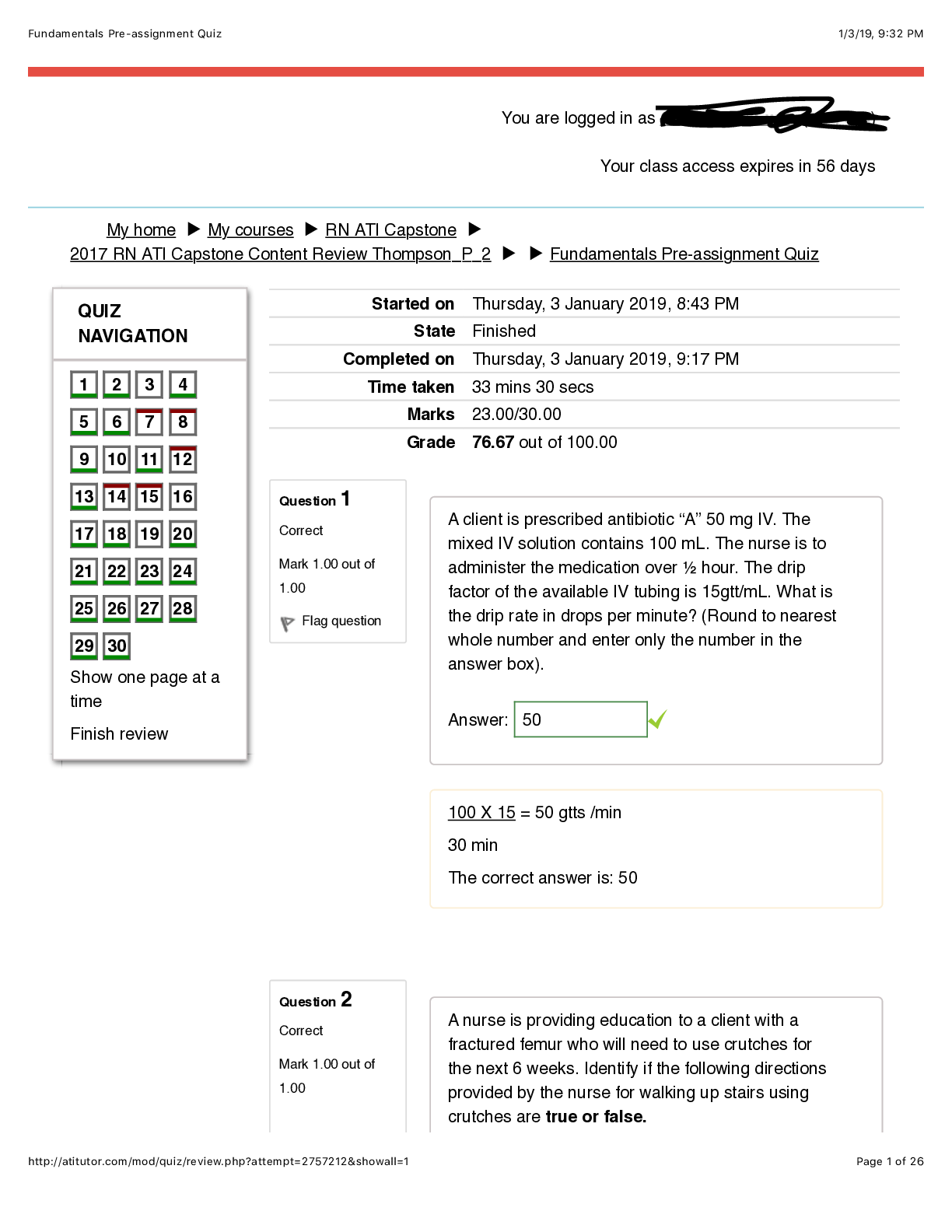

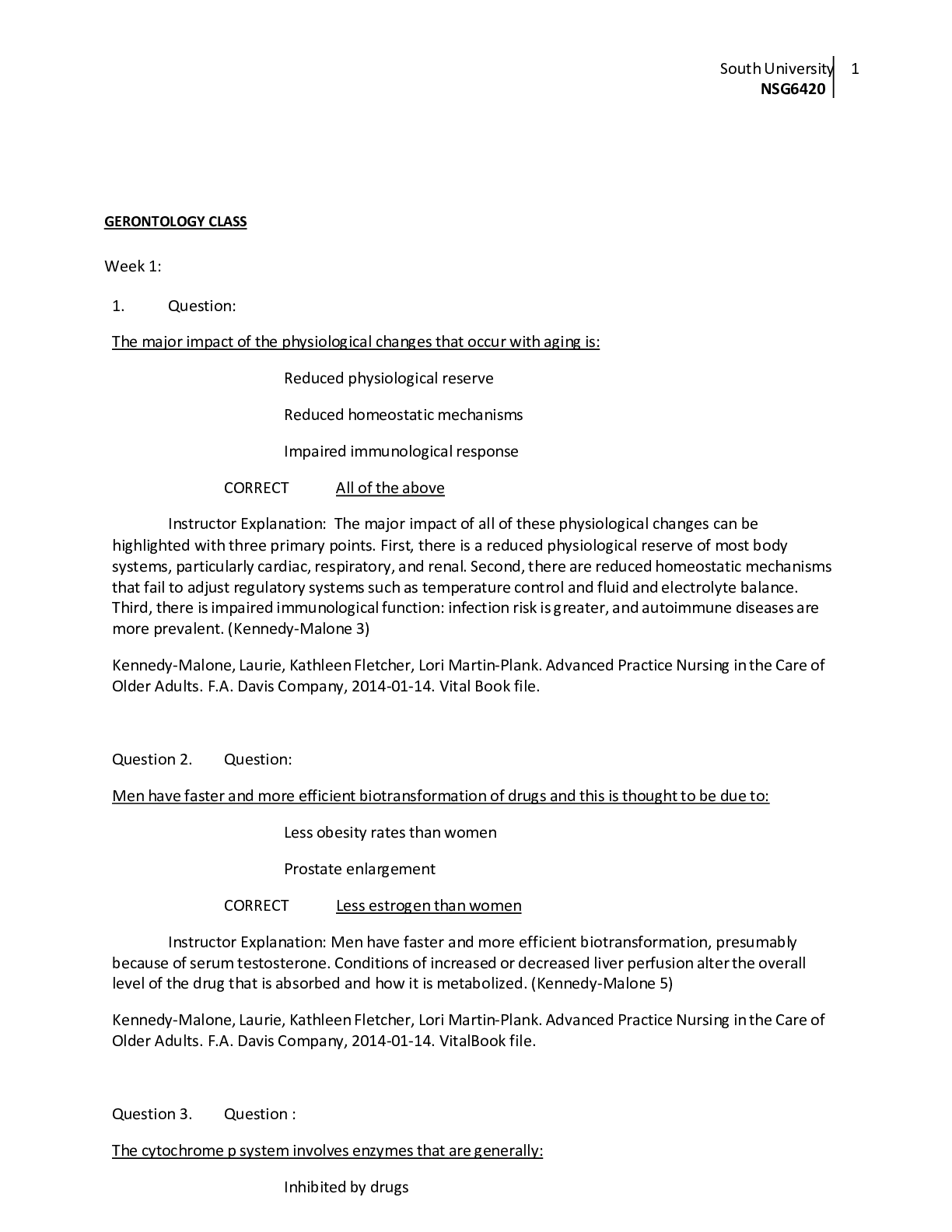
.png)


